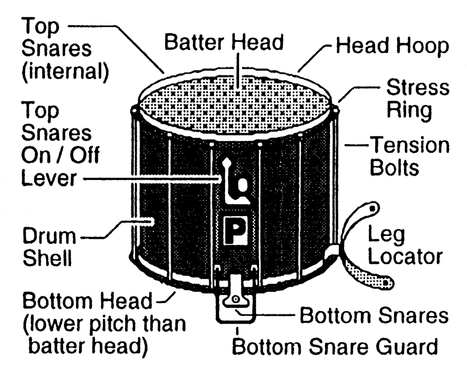The Pipe Band Snare (Side) Drum
 The Pipe Band Snare Drum
The Pipe Band Snare Drum
A pipe band snare drum consists of a Kevlar top head and a plastic bottom head, a rigid shell, multiple spring-like snares and two sticks to batter the top head in a series of taps and rolls. Many fine-tuning adjustment mechanisms are located inside, as well as, outside the drum. All this is needed to keep the pipers in line and on the beat. The snare drum has come a long way from the hide-covered drums of yesteryear.
Scottish snare drums are tuned to a much higher pitch than those found in American marching bands. This makes the heads much harder and stick control more difficult, but it is necessary to get the classic Scottish “buzzy” sound out of the drum. (Note: A wee dram is needed to give a drummer the classic Scotch “buzz.”)
The early style of pipe band side drumming was most likely similar to that played in a fife and drum corps. A revision in drumming style was required to suit the needs of the highly rhythmic 2/4, 3/4, 4/4 and 6/8 marches played by the pipes. These revisions came in the form of patterns and accents, all to help “point” the melody for the pipers and to be a more flattering accompaniment.
Other drums in the band are the large bass drum, keeping the tempo as set by the Pipe Major, and the tenor drums, with tempo accents and intricate stick flourishes. These drums make up the bass section of a pipe band drum corps.
Scottish snare drums are tuned to a much higher pitch than those found in American marching bands. This makes the heads much harder and stick control more difficult, but it is necessary to get the classic Scottish “buzzy” sound out of the drum. (Note: A wee dram is needed to give a drummer the classic Scotch “buzz.”)
The early style of pipe band side drumming was most likely similar to that played in a fife and drum corps. A revision in drumming style was required to suit the needs of the highly rhythmic 2/4, 3/4, 4/4 and 6/8 marches played by the pipes. These revisions came in the form of patterns and accents, all to help “point” the melody for the pipers and to be a more flattering accompaniment.
Other drums in the band are the large bass drum, keeping the tempo as set by the Pipe Major, and the tenor drums, with tempo accents and intricate stick flourishes. These drums make up the bass section of a pipe band drum corps.
